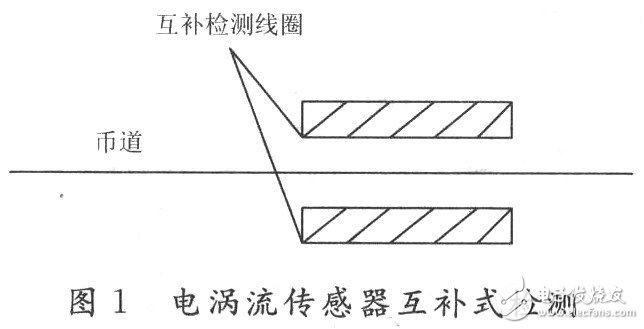The identification of coins is divided into two aspects: accurate detection of coin value; accurate identification of genuine coins and counterfeit coins. Due to the complexity of coins, the accurate identification of coins has not been well solved for a long time. At present, the usual solution is based on the eddy current testing method of single-chip microcomputer, whether it is foreign or domestic. Based on the eddy current testing, this paper uses the fast processing characteristics and high reliability of the FPGA to accurately detect the thickness, diameter, material, conductivity and magnetic permeability of the coin in order to accurately identify the coin.
1 Principle of eddy current reflection complementary detection sensorEddy current testing is a non-destructive testing method based on the principle of electromagnetic induction. It is suitable for conductive materials. If a conductor is placed in an alternating magnetic field, there is an induced current in the conductor, that is, eddy current is generated. The change of the induced current due to various factors of the conductor itself (such as conductivity, permeability, shape, size and defects), the use of this phenomenon to determine the nature of the conductor, the detection method of the state, called eddy current testing law.
In the eddy current detection, the detecting coil is used to establish an alternating magnetic field; the energy is transmitted to the detected conductor, and at the same time, the alternating magnetic field established by the eddy current obtains the quality information in the detected conductor.
In the coin recognizer, the probe coil is used, and since the coin rolls in the coin path, it has a slight jitter in the radial position. In order to eliminate the influence of the jitter, the detection coil is installed on both sides of the coin channel. , perform probe complementary detection. As shown in Figure 1.

The detecting coil and the detecting circuit form an oscillator. When the coin passes through the coin channel, the inductance of the coil changes, causing the oscillation frequency of the detecting circuit to change. The oscillation frequency is detected by the FPGA to correctly identify the coin.
2 FPGA-based equal displacement multi-point sampling principleWhen a coin passes through the detection coil, it causes a change in the oscillation frequency. The conventional detection method usually detects the extreme value of the varying oscillation frequency, that is, the maximum value. However, this detection method has only one sampling point, and the ability to identify counterfeit currency is not strong. Some people also take sampling points every time for the same time, and improve the recognition effect by multi-sampling points. However, when the coin passes through the coin channel, due to the difference in coin strength, initial speed, and the smoothness of the edge of the coin, the weight of the coin, etc., not every coin passes through the detection coil at the same speed; the same kind, Even the same coin does not always have the same speed every time the coil is detected. Therefore, if sampling is taken at equal intervals, the physical relative position of the coin and the detecting coil will be different when sampling, and the detection result will be different. This not only causes the accuracy of reliable identification of counterfeit currency, but also affects the reliability of currency detection and real currency recognition of genuine coins, and even recognizes genuine coins as counterfeit coins. Because of these problems, in the actual coin identifier product, it is usually adopted to take only one sampling point, that is, the extreme value sampling method, but this single point sampling method is only acquired at a certain moment when the coin passes through the coin channel. The parameter information of the coin has great limitations, and the ability to identify the counterfeit currency is not strong.
In this design, the equal displacement multi-point sampling method is adopted, which completely overcomes the shortcomings of the above methods and has a high ability to understand coins. At the same time, the diameter of the coin can be detected.
Because the sampling time and sampling interval are very short, the system has high requirements for high speed and reliability. It is difficult to meet the requirements with traditional single-chip microcomputer. In this design, high-speed sampling and processing of data is completed by FPGA.
Phone charger
Phone Charger,Universal Car Charger,Car Charger Adapter for Wall Plug,Car Charger Voltage
Pogo Technology International Ltd , https://www.wisesir.net